
Concept explainers
10 minutes per unit. Part 2 is simultaneously processed at work-station C for 20 minutes per unit. Work stations B and C feed the parts to an assembler at workstation D. w here the two parts are assembled. The time at workstation D is 15 minutes.
a) What is the bottleneck of this process?
b) What is the hourly capacity of the process?
•• S7.15 A production process at Kenneth Day Manufacturing is shown in Figure S7.9. The drilling operation occurs separately from, and simultaneously with, sawing and sanding, which are independent and sequential operations. A product needs to go through only one of the three assembly operations (the operations are in parallel).
a) Which operation is the bottleneck?
b) What is the bottleneck time?
c) What is the throughput time of the overall system?
d) If the firm operates 8 hours per day. 20 days per month, what is the monthly capacity of the manufacturing process?
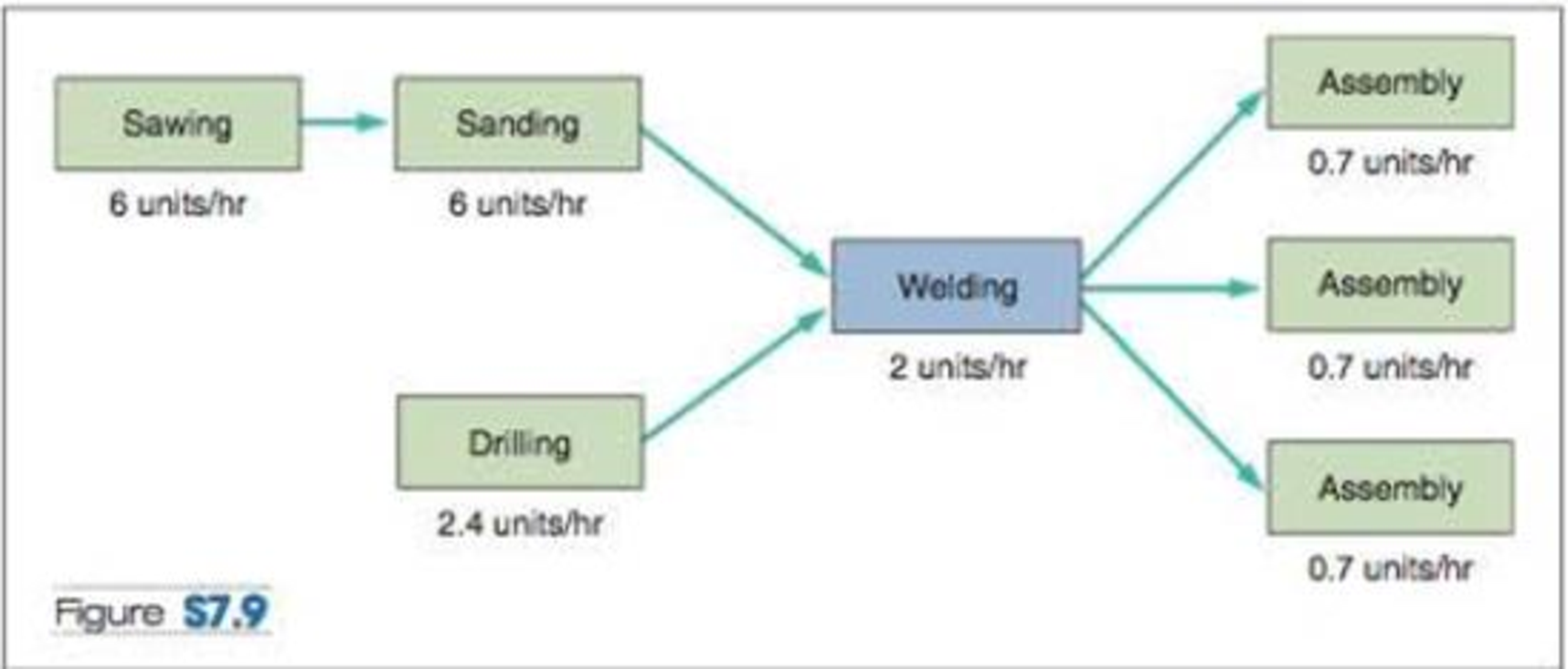
a)
To determine: The bottleneck operation.
Introduction:
Bottleneck time:
The bottleneck time of the system is the process in the system which takes the most amount of time to complete its activity. The bottleneck time will reduce the overall efficiency of the system.
Answer to Problem 15P
The bottleneck operation is Welding.
Explanation of Solution
Given information:
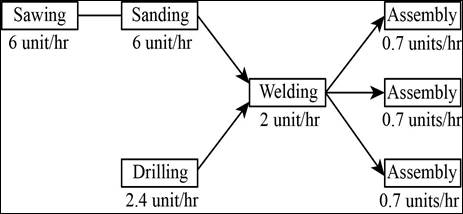
Formula to convert capacity into process time:
Formula to calculate overall assembly operation process time:
Calculation of process time for each operation:
The process time of each station is calculated by dividing the number of minutes with the production capacity of the station.
Sawing:
Sanding:
Drilling:
Sawing:
Welding:
Assembly at one operation:
Calculation of overall assembly operation process time:
The overall assembly operation process time is calculated by dividing the process time at one assembly operation by the Number of assembly operations.
Identification of the bottleneck time of the system:
The bottleneck time of the system is the operation which has the highest process time. Welding has the highest process time when compared to the other operations (30>10, 10, 25, 10, 28.57). Hence, the bottleneck time of the system is 30 minutes per unit.
Therefore, the bottleneck operation is Welding.
b)
To determine: The bottleneck time of the bottleneck operation.
Introduction:
Bottleneck time:
The bottleneck time of the system is the process in the system which takes the most amount of time to complete its activity. The bottleneck time will reduce the overall efficiency of the system.
Answer to Problem 15P
The bottleneck time of the bottleneck operation is 30.
Explanation of Solution
Given information:
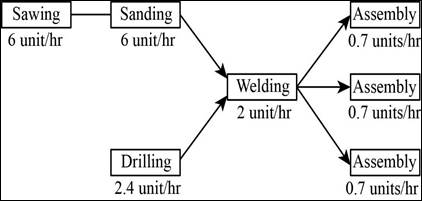
Formula to convert capacity into process time:
Formula to calculate overall assembly operation process time:
Calculation of process time for each operation:
The process time of each station is calculated by dividing the number of minutes with the production capacity of the station.
Sawing:
Sanding:
Drilling:
Sawing:
Welding:
Assembly at one operation:
Calculation of overall assembly operation process time:
The overall assembly operation process time is calculated by dividing the process time at one assembly operation by the number of assembly operations.
Identification of the bottleneck time of the system:
The bottleneck time of the system is the operation which has the highest process time. Welding has the highest process time when compared to the other operations (30 > 10, 10, 25, 10, 28.57). The bottleneck operation is Welding.
Hence, the bottleneck time of the bottleneck operation is 30 minutes per unit.
c)
To determine: The throughput time of the time of the overall system.
Introduction:
Throughput time:
The throughput time of a system is the time taken for a product to pass from the raw materials stage to the finished goods stage. The higher the throughput time the more efficient the system will be.
Answer to Problem 15P
The throughput time of the overall system is 140.71 minutes.
Explanation of Solution
Given information:
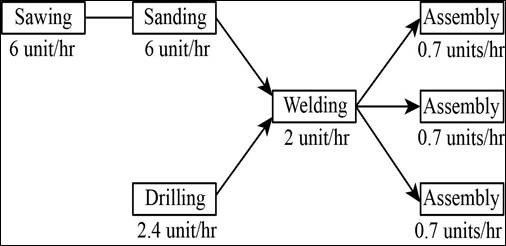
Formula to convert capacity into process time:
Formula to calculate throughput time:
Calculation of process time for each operation:
The process time of each station is calculated by dividing the number of minutes with the production capacity of the station.
Sawing:
Sanding:
Drilling:
Sawing:
Welding:
Assembly at one operation:
Calculation of throughput time:
The throughput time is calculated by identifying the maximum value of the summation of process times of Sanding, Sawing, Welding, assembly and the summation of process times of Drilling, Welding, and Assembly.
Hence, the throughput time of the overall system is 140.71 minutes.
d)
To determine: The monthly capacity of the manufacturing process.
Introduction:
Bottleneck time:
The bottleneck time of the system is the process in the system which takes the most amount of time to complete its activity. The bottleneck time will reduce the overall efficiency of the system.
Monthly capacity:
The monthly capacity is the number of units the firm is able to produce in a month’s time. It will be calculated taking into consideration of the resources and constraints present in the manufacturing process.
Answer to Problem 15P
The monthly capacity of the manufacturing process is 320 units per month.
Explanation of Solution
Given information:
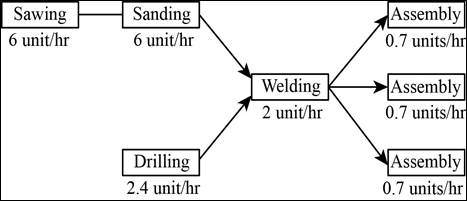
Operating time = 60 minutes / 8 hour / day
Number of days = 20 / month
Formula to convert capacity into process time:
Formula to calculate overall assembly operation process time:
Formula to calculate monthly capacity:
Calculation of process time for each operation:
The process time of each station is calculated by dividing the number of minutes with the production capacity of the station.
Sawing:
Sanding:
Drilling:
Sawing:
Welding:
Assembly at one operation:
Calculation of overall assembly operation process time:
The overall assembly operation process time is calculated by dividing the process time at one assembly operation by the Number of assembly operations.
Identification of the bottleneck time of the system:
The bottleneck time of the system is the operation which has the highest process time. Welding has the highest process time when compared to the other operations (30 > 10, 10, 25, 10, 28.57). Hence, the bottleneck time of the system is 30 minutes per unit.
Calculation of monthly capacity:
The monthly capacity is calculated by multiplying the operating time per day with the number of days per month and dividing the resultant value with the bottleneck time of the system.
Hence, the monthly capacity of the manufacturing process is 320 units per month.
Want to see more full solutions like this?
Chapter 7 Solutions
Principles Of Operations Management
- An assembly line must be designed to produce 40 containers per hour. The following data give the necessary information Table 1 TASK IMMEDIATE PREDECESSOR TASK TIME (sec) A None 60 B A 12 C B 35 D A 55 E D 10 F E 50 G F, C 5 Draw the precedence diagram. ii. Compute the cycle time (in seconds) to achieve the desired output rate. iii. What is the theoretical minimum number of stations? iv. Assign the tasks to workstation? v. What is the efficiency of the line? PLEASE ANSWER THE FOLLOWING QUESTIONS: iV, & v.arrow_forwardCalifornia Gardens, Inc., prewashes, shreds, and distributes a variety of salad mixes in 2-pound bags. Doug Voss, Operations VP, is considering a new Hi-Speed shredder to replacethe old machine, referred to in the shop as "Clunker." Hi-Speed will have a fixed cost of $85,000 per month and a variable cost of $1.25 per bag. Clunker has a fixed cost of only $44,000 per month, but a variable cost of$ 1.75. Selling price is $2.50 per bag.a) What is the crossover point in units (point of indifference) for the processes?b) What is the monthly profit or loss if the company changes to the Hi-Speed shredder and sells 60,000 bags per month? c) What is the monthly profit or loss if the company stays with Clunker and sells 60,000 bags per month?arrow_forwardwhy is capacity planning important ? what are the goals of facility layout?arrow_forward
- California Gardens, Inc., prewashes, shreds, and dis-tributes a variety of salad mixes in 2-pound bags. Doug Voss, Operations VP, is considering a new Hi-Speed shredder to replacethe old machine, referred to in the shop as “Clunker.” Hi-Speedwill have a fixed cost of $85,000 per month and a variable costof $1.25 per bag. Clunker has a fixed cost of only $44,000 permonth, but a variable cost of $1.75. Selling price is $2.50 per bag.a) What is the crossover point in units (point of indifference) forEric Limon/ Shutterstock the processes? b) What is the monthly profit or loss if the company changes tothe Hi-Speed shredder and sells 60,000 bags per month?c ) What is the monthly profit or loss if the company stays withClunker and sells 60,000 bags per month?arrow_forwardCalifornia Gardens, Inc., prewashes, shreds, and distributes a variety of salad mixes in 2-pound bags. Doug Voss, Operations VP, is considering a new Hi-Speed shredder to replace the old machine, referred to in the shop as "Clunker." Hi-Speed will have a fixed cost of $87,000 per month and a variable cost of $1.20 per bag. Clunker has a fixed cost of only $31,000 per month, but a variable cost of $1.70. Selling price is $2.40 per bag. Part 2 a) What is the crossover point in units (point of indifference) for the processes? The crossover point is units. (Round your response to the nearest whole number.)arrow_forwardCalifornia Gardens, Inc., prewashes, shreds, and distributes a variety of salad mixes in 2-pound bags. Doug Voss, Operations VP, is considering a new Hi-Speed shredder to replace the old machine, referred to in the shop as "Clunker." Hi-Speed will have a fixed cost of $87,000 per month and a variable cost of $1.20 per bag. Clunker has a fixed cost of only $31,000 per month, but a variable cost of $1.70. Selling price is $2.40 per bag. Part 2 a) What is the crossover point in units (point of indifference) for the processes? The crossover point is 112000112000 units. (Round your response to the nearest whole number.) Part 3 b) What is the monthly profit or loss if the company changes to the Hi-Speed shredder and sells 90,000 bags per month? The monthly profit or loss if the company changes to the Hi-Speed shredder and sells 90,000 bags per month is $enter your response here. (Round your response to the nearest dollar and include a minus sign if necessary.)arrow_forward
- California Gardens, Inc., prewashes, shreds, and distributes a variety of salad mixes in 2-pound bags. Doug Voss, Operations VP, is considering a new Hi-Speed shredder to replace the old machine, referred to in the shop as "Clunker." Hi-Speed will have a fixed cost of $87,000 per month and a variable cost of $1.20 per bag. Clunker has a fixed cost of only $31,000 per month, but a variable cost of $1.70. Selling price is $2.40 per bag. a) What is the crossover point in units (point of indifference) for the processes? The crossover point isunits. (Round your response to the nearest whole number.)arrow_forwardList some practical limits to economies of scale. In other words, when should a plant stop growing?arrow_forwardBriefly det the two main layout types?arrow_forward
- Explain what is meant by bottleneck analysis in operations ?arrow_forwardDescribe an application, other than ware house layout decision, where ranking items according to bang/buck makes sense ?arrow_forwardExplain the techniques to deal with bottleneck operations and some of those techniques that does not decrease throughput time ?arrow_forward
 Practical Management ScienceOperations ManagementISBN:9781337406659Author:WINSTON, Wayne L.Publisher:Cengage,
Practical Management ScienceOperations ManagementISBN:9781337406659Author:WINSTON, Wayne L.Publisher:Cengage, Operations ManagementOperations ManagementISBN:9781259667473Author:William J StevensonPublisher:McGraw-Hill Education
Operations ManagementOperations ManagementISBN:9781259667473Author:William J StevensonPublisher:McGraw-Hill Education Operations and Supply Chain Management (Mcgraw-hi...Operations ManagementISBN:9781259666100Author:F. Robert Jacobs, Richard B ChasePublisher:McGraw-Hill Education
Operations and Supply Chain Management (Mcgraw-hi...Operations ManagementISBN:9781259666100Author:F. Robert Jacobs, Richard B ChasePublisher:McGraw-Hill Education
 Purchasing and Supply Chain ManagementOperations ManagementISBN:9781285869681Author:Robert M. Monczka, Robert B. Handfield, Larry C. Giunipero, James L. PattersonPublisher:Cengage Learning
Purchasing and Supply Chain ManagementOperations ManagementISBN:9781285869681Author:Robert M. Monczka, Robert B. Handfield, Larry C. Giunipero, James L. PattersonPublisher:Cengage Learning Production and Operations Analysis, Seventh Editi...Operations ManagementISBN:9781478623069Author:Steven Nahmias, Tava Lennon OlsenPublisher:Waveland Press, Inc.
Production and Operations Analysis, Seventh Editi...Operations ManagementISBN:9781478623069Author:Steven Nahmias, Tava Lennon OlsenPublisher:Waveland Press, Inc.





